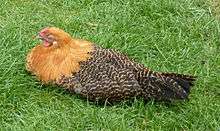Westfälischer Totleger
 Westfälischer Totleger hen | |
| Country of origin | Germany |
|---|---|
| Traits | |
| Weight | Male: 2–2.5 kg [1] |
| Female: 1.5–2 kg[1] | |
| Egg color | white |
| Classification | |
|
Chicken Gallus gallus domesticus | |
The Westfälischer Totleger is a German breed of domestic chicken. It is more than 400 years old, and is a rare breed. As of 2009, only 301 roosters and 1353 hens were officially registered.[1][2]
Name
Although the German word "Tot" means "death" and "Leger" means non-sitters (hens which lay eggs), the real meaning is another. Due to the considerable ability to produce eggs, the breed was called "Alltagsleger" (each day nonsitters, it means it lays an egg each day) or "Dauerleger". Under the influence of Low German the name changed into "Doutleijer". Later, from this Low German word, it developed into "Totleger". Derivation from "lays eggs till the death" is thus not correct.[3]
Origin
It is an old landrace from Westphalia. It is closely related to the Ostfriesische Möwe and Braekel.
Description
It is kept in 2 colours: Gold Pencilled and Silver Pencilled. The roosters weigh 2-2,5 kg and the hens from 1,5–2 kg. The hens are non-sitters, produce 200-243 eggs per year of 55-65 g weight.
References
- 1 2 3 Das westfälische Totlegerhuhn
- ↑ "Rote Liste der gefährdeten einheimischen Nutztierrassen in Deutschland" (PDF). Bundesanstalt für Landwirtschaft und Ernährung (BLE). 2010. Retrieved 2011-02-23.
- ↑ Unterweger, Wolf-Dietmar: Das Hühnerbuch: Praxisanleitung zur Haltung "glücklicher Hühner", Graz 2004, 2. Aufl., S. 125